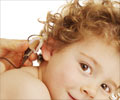- US Preventive Services Task Force. Universal Screening for Hearing Loss in Newborns: US Preventive Services Task Force Recommendation Statement. Pediatrics 2008;122:143–148
- M. Shamim Ansari. Screening programme for Hearing Impairment in Newborns: A Challenge during Rehabilitation for All. Asia Pacific Disability Rehabilitation Journal. 2004;15(1):83-9.
- A. Stevens Wrightson. Universal Newborn Hearing Screening. Am Fam Physician 2007;75:1349-1352.
Screening with Hearing Tests
Ideally, screening tests for hearing loss should be conducted before the infant is 1 month of age.
Who should undergo screening with hearing tests?
Current recommendations indicate that all newborns before the age of 1 month should undergo screening with
What are the tests done to check for hearing during screening?
The following tests are used for screening for hearing loss:
- Otoacoustic emissions (OAEs): This is a reliable test that detects even mild hearing loss. It can be performed by a non-audiologist as well. A small probe is inserted into the ear canal of the baby and is connected to the recorder in a quiet room. A small sound like a click serves as the stimulus. This results in minute vibrations in a normally functioning inner ear, which are picked up by the probe. The test can be performed in as less as a few seconds. Sometimes, debris or fluid in the ear may result in a wrong diagnosis. In such cases, the test could be repeated or the auditory brainstem response test can be performed.
- Auditory brainstem response (ABR) test: This test is done in those who failed the otoacoustic emissions test. During this test, an electrical response is evoked in response to a click stimulus introduced to earphones placed in the ears, which is recorded using electrodes placed on the head of the baby. The baby may require sedation for this test.







